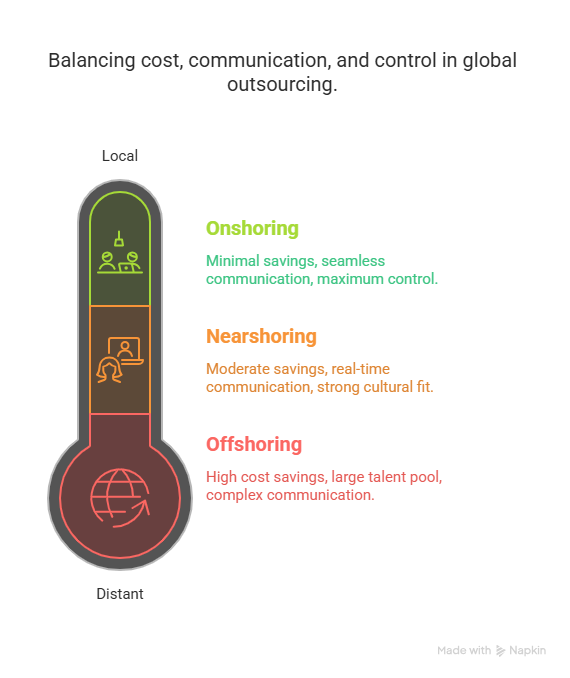
Contents
Imagine you are an American CTO, staring at a project timeline that’s alarmingly getting complex. Your software development team maxed out. New features are piling up, bugs are creeping in, and your customers are getting impatient. You are in need of more developers, but hiring is crazy expensive. Not to mention, developer salaries in the US are topping $120,000 a year. Plus, you also need to expand your office capacity to accommodate them.
What options do you have? Outsourcing, right? Depending on the geographic distance, there are three arrangements of outsourcing: Offshoring, Nearshoring, and Onshoring.
Comparing the Three Outsourcing Arrangements

Every option comes with a catch. Hiring in-house talent means long recruitment cycles and costs. Offshoring to distant countries offers cost savings but introduces newer challenges. The concerns are significant time differences, security risks, cultural nuances, and quality control. According to IBM’s Cost of a Data Breach Report 2024, the global average cost of a data breach is $4.88 million. It is the highest total ever and a 10% increase from the previous year. This growing cost of data breach warns us of the growing security risk concern. Moreover, there are cases of vendors overpromising and underdelivering. Some of them even get derailed by miscommunication.
How Nearshoring Can Save You from the Offshoring Pitfalls
While outsourcing is complex, nearshoring helps you avoid those offshoring pitfalls. As an US-based company, you can work with teams in nearby countries like Mexico, Colombo, or Uruguay. Costs are lower, time zones align, and cultural vibes match up. However, you still need to run some due diligence to dodge risks like quality issues and data breaches. Make sure to thoroughly review the companies and pick the right ones as per your requirements.
Save Cost without Compromising Quality
Nearshoring can cut your development costs by up to 50% compared to hiring in the US. That’s like getting a premium service at a discount. You get high-quality work without the hefty price tag. Software companies in Latin America offer competitive prices.
Talk Like You are in the Same Room
Forget late-night calls or waiting days for replies. Nearshore teams in Latin America share similar time zones. This lets you chat in real time. You can solve problems quickly and keep projects on track. It feels like having a team just down the hall, not across the globe.
Tap into a Talent Goldmine
Latin America is bursting with tech talent, and it is growing as countries invest in tech education. Whether you need coders, cybersecurity experts, or QA pros, you’ll find them here.
Work with People Who Understand You
Cultural alignment matters. Latin American teams often share similar work ethics and culture. The majority of them are proficient in English. This means fewer misunderstandings and stronger collaboration.
Keep Your Data Safe
Top nearshoring vendors in LATAM follow global standards like ISO 27001, ensuring that your data is safe with them. This is a major concern for fields like fintech or healthcare, where one breach can be disastrous.
Presence of Global IT Companies in Latin America
SAP
The enterprise software leader SAP has established nearshoring centers in countries such as Argentina and Mexico. This strategic move helped SAP tap into a skilled workforce. They are up to date with the latest technologies and methods. Nearshoring has helped SAP cut development costs, improve customer support, and provide faster, customized solutions. SAP includes a team of over 1,800 and 1,600 employees in Mexico and Argentina, respectively.
IBM
IBM, a pioneer in tech innovation, has embraced nearshoring by setting up operations in Brazil and Mexico. This move lets IBM tap into skilled IT workers and save on costs. The nearshoring model helps the company enhance services and speed up project deliveries. IBM employed over 11,000 people in Brazil and 6,400 people in Mexico, with the majority working in engineering, IT, operations, project management, and business development.
Globant
Globant is an IT services company. It is based in Luxembourg but mainly (44% of the workforce) operates in Latin America. The company focuses on digital transformation and engineering services.
Evaluation of the Top 5 LATAM Countries for Nearshoring IT Services
The table below shows how Mexico, Brazil, Colombia, Argentina, and Costa Rica stack up for nearshoring IT services to the US. We sourced the data from industry reports, government statistics, and reputable analyses. We looked at each criterion to provide useful insights for C-suite leaders in IT and IT-enabled industries. This includes sectors like fintech, healthcare, and e-commerce. These leaders want quality, cost efficiency, and long-term ROI.
Key Takeaways
-
Mexico: Best for proximity, cost savings, and large-scale projects in enterprise software and IoT. Ideal for US firms prioritizing travel ease and time zone alignment (CST).
-
Brazil: Known for its deep talent and strong AI/fintech skills. However, costs are high, and regulations are complex. This makes it important to have experienced partners. Best for innovative, high-budget projects.
-
Colombia: Rising star with competitive rates, strong English proficiency, and Eastern Time alignment. Suited for agile web development and QA projects.
-
Argentina: Stands out for its high proficiency in English. It also excels in blockchain and AI. Tax incentives make these services more affordable. Best for creative tech and long-term partnerships.
-
Costa Rica: A top choice for high-quality niche projects like QA and cybersecurity. It offers excellent stability and strong IP protection. Higher costs and smaller talent pool limit scalability.
Challenges of Nearshoring IT Services to Latin America
Nearshoring IT services to Latin America offers US companies cost savings, time zone alignment, and access to tech talent. However, strategic decision-makers must weigh significant challenges to ensure informed decisions. Here are some caveats you should keep in mind before deciding to go for nearshoring in Latin America.
Higher Costs Compared to Offshoring
Nearshoring to Latin America costs more than offshoring to Asia. For example, developer rates in LATAM range from $20 to $60 per hour. This is 30 to 50% higher than India, where rates are $15 to $40 per hour. As a result, budget-conscious firms see less cost savings.
Variable English Proficiency
While countries like Argentina (EF EPI score: 551) and Costa Rica (535) have high English proficiency, Brazil (473) and Mexico (486) lag behind. This gap can cause misunderstandings in technical talks or documents. The 2024 EF English Proficiency Index shows that Latin America has a moderate ranking. This increases reliance on bilingual project managers, adding costs.
Cybersecurity and IP Protection Risks
Some Latin American countries have weak cybersecurity frameworks. There is a risk of exposing sensitive data and intellectual property (IP). While Costa Rica and Argentina meet US standards, Brazil and Colombia have gaps in enforcement. The 2024 Global Cybersecurity Index ranks Mexico at 76/100 and Colombia at 78/100. The US scores higher at 94/100. Some nearshoring contracts in Latin America lack strong IP clauses. This increases risks for US firms.
Way Forward
As the demand for faster innovation and scalable development grows, US tech leaders must make sharper decisions about team expansion. Nearshoring to Latin America is a smart choice. It offers real-time collaboration, lower costs, and skilled talent, without the downsides of distant outsourcing.
Nearshoring isn’t just about cutting costs. It’s about working smarter in a competitive tech market. By choosing the right partners and making clear plans, companies can stay agile, secure, and competitive. This helps them gain long-term value. Choose the right nearshore partner, and your product release will be ahead of the curve.
FAQ
Q: What’s the difference between nearshoring and offshoring?
A: Nearshoring is when companies work with nearby countries. For example, US firms often partner with Mexico. This helps with communication and keeps time zones aligned. Offshoring involves distant regions, often with bigger time gaps and cultural differences.
Q: Why choose Latin America for nearshoring?
A: Latin America offers skilled talent, lower costs, and cultural compatibility with the US, plus proximity for seamless collaboration.
Q: How can I ensure data security with nearshoring?
A: Look for partners with ISO 27001 certification and robust data protection policies to keep your information safe.
Q: What kind of cost savings can I expect?
A: Nearshoring can cut development costs by up to 50% compared to local hiring in the US, while maintaining high quality.






